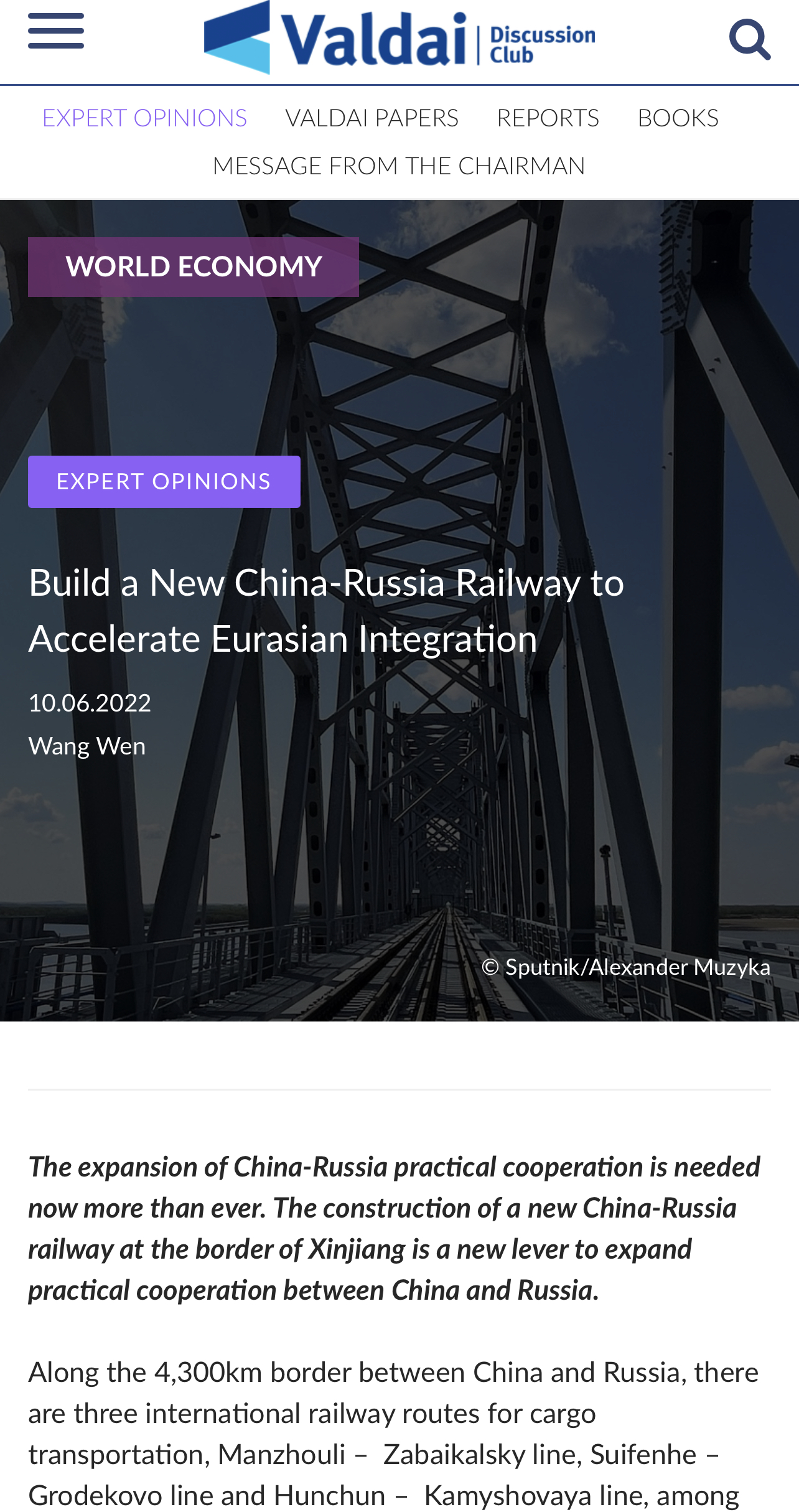编者按:欧亚经济论坛2022年年会于5月26日在吉尔吉斯斯坦首都比什凯克举行,俄罗斯总统普京视频致辞,来自欧亚经济联盟国家的2500多名官员学者与社会人士参加。在主题为“欧亚经济联盟与未来的国际伙伴互动”分论坛上,中国人民大学重阳金融研究院(人大重阳)执行院长王文受邀做《建新的中俄铁路,加速欧亚一体化》的主题发言,受到在场的广泛认可。俄罗斯顶级智库瓦尔代俱乐部官网以英文、俄文方式于6月10日刊发了此次发言内容。现将相关现场视频与内容中英文版推荐如下。

王文在欧亚经济论坛2022年年会分论坛发表主题演讲的现场视频
现在比任何时候都更需要中俄务实合作的拓展。在中俄新疆交界处修建一条新的中俄铁路,是拓展中俄务实合作的新杠杆。
在中俄两国4300公里的边境线上,有三条货物运输的国际铁路路线,珲春-卡米索维亚、满洲里-外贝加尔斯克路线、绥芬河-格罗捷阔沃路线,其中后两条的过货量几乎占了中俄铁路过境货物量的全部。而在中国西部的新疆阿勒泰地区与俄罗斯阿尔泰边疆区54公里的接壤处,却没有铁路连接,这成为限制中俄贸易与经济合作的瓶颈。
在中国这一边,铁路网已延伸至阿勒泰市,只需要再延伸180公里就可到中俄边境。铁路口岸可选在禾木县吉克普林,那里平均海拔2500米,地势相对平坦,距离中俄边境约50公里。
在俄罗斯一边是阿尔泰边疆区。该区的比斯克市往南离俄中边境仅370公里,往北则可连入新西伯利亚铁路。阿尔泰边疆区是俄罗斯重要的商品粮和畜牧业基地。与其相邻的克麦罗沃州工业发达,煤炭总产量占俄罗斯的50%以上。
从技术上看,从俄罗斯的比斯克到中国的阿勒泰,修建这条约550公里的铁路,对拥有超过20万公里铁路里程的中俄两国来说,并不是难事。
如果这条铁路修建成功,至少有三层重大意义。
第一,将会极大增强中俄战略协同合作的深度以及欧亚经济一体化的进程。这条铁路将成为一条重要的战略通道,推动维护与巩固两国产业链供应链的安全。
第二,将会缓解当前中欧班列的压力。目前中欧班列已趋于饱和,2021年开行15000余列,其中50%以上都通过新疆霍尔果斯出境,经哈萨克斯坦到达欧洲,承载量已相当大,影响下一步的增长,急需要一条新的铁路来缓解哈萨克斯坦方面的压力。
第三,将会极大促进俄罗斯与中国的区域发展。俄罗斯经济重心在欧亚大陆的西部,中国经济重心在欧亚大陆的东部。这条铁路对中俄两国而言,都会起到经济发展再平衡的作用。以中国为例,新疆对俄贸易仅仅占中俄贸易的9%,新的中俄铁路将极大提升新疆在中国新发展格局中的地位。
目前中俄两国的地方政府与铁路公司都热切希望修建这条新的中俄铁路。从公开新闻报道中得知,俄罗斯铁路公司、阿尔泰边疆区、克麦罗沃州、西伯利亚州政府对此都十分期盼。中国新疆对铁路选线和口岸选址都进行了初步勘察,认为建设该项目技术层面没有大的障碍。
现在最大的障碍在于两国中央政府的战略意志。在国际舆论压力以及双方中央政府都有更紧要的工作日程下,如何将双方地方政府与企业层面的意愿升级为国家意志,显得非常关键。
还有一个障碍是对环境的影响评估。如果修建这条铁路,会经过喀纳斯国家自然保护区与阿尔泰自然保护区。想要建设这条铁路,需要两国对各自环境保护法律进行修正,还必须在施工时尽可能少地影响环境,是最大的难点。
其实,新中俄铁路的修建难度,折射了中俄务实战略合作与欧亚一体化进程的关键难点。困难不是来源于资金、技术、人力或地方政府的意愿,而是在于战略意志力。
相信在两国中央政府的共同努力下,这条新中俄铁路一定能够在不久的将来启动并正式开通。那样欧亚大陆经济合作将是另一番盛况。
以下为英文版

Build a New China-Russia Railway to Accelerate Eurasian Integration
By Wang Wen
The expansion of China-Russia practical cooperation is needed now more than ever. The construction of a new China-Russia railway at the border of Xinjiang is a new lever to expand practical cooperation between China and Russia.
Along the 4,300km border between China and Russia, there are three international railway routes for cargo transportation, Manzhouli – Zabaikalsky line, Suifenhe – Grodekovo line and Hunchun – Kamyshovaya line, among which the Manzhouli - Zabaikalsky line and Suifenhe - Grodekovo line account for almost all the transit cargo volume of China-Russia railway. However, there is no railway connection at the 54km junction between Altay Prefecture of Xinjiang in western China and the Altai Republic of Russia, which has become a bottleneck limiting trade and economic cooperation between Russia and China.
On the Chinese side, the railway network already has been extended to Altay city and only needs another 180km to reach the Russian-Chinese border. The railway port can be located in Jikepulin, Hemu, where the average altitude is 2,500 meters and the terrain is relatively flat, about 50 kilometers from the Russian-Chinese border.
On the Russian side is the Altai Republic. The city of Biysk lies only 370 kilometers to the south of the Russia-China border and is connected to the Novosibirsk railway to the north. it is situated in the Altai Krai, an important base of commodity grain and animal husbandry in Russia. The neighboring Kemerovo is industrially developed and accounts for more than 50% of Russia's total coal production.
Technically, the construction of this approximately 550 km railway from Russia's Biysk to China's Altay is not difficult for both countries, which have more than 200,000 km of track.
If this railway is built successfully, it will have at least three levels of great significance.
First, it will greatly enhance the depth of China-Russia strategic coordination and cooperation as well as the process of Eurasian economic integration. The railway will serve as an important strategic corridor to safeguard and consolidate the security of the industrial and supply chains of both countries.
Second, it will relieve the pressure on the current China-Europe freight trains. The current China-European Liner has tended to saturate, with more than 15,000 trains running in 2021, of which more than 50% are outbound through Xinjiang Horgos and reach Europe via Kazakhstan. The capacity of the existing railway is already large enough to affect further growth, and a new railway is urgently needed to relieve the pressure on Kazakhstan side.
Third, it will significantly promote the regional development of Russia and China. The center of gravity of the Russian economy is in the west of Eurasia, China's economic center of gravity is in the east of Eurasia. The railway will play a role in rebalancing the economic development of both countries. In China, for example, Xinjiang's trade with Russia accounts for only 9% of Russian-Chinese trade. The new China-Russia railway will greatly enhance Xinjiang's position in China's new development landscape.
At present, local authorities and railway companies of both countries are keen to build the new Russian-Chinese railway. According to public press reports, the Russian Railways, the Altai Republic, the Altai Krai, Kemerovo and Siberia are all looking forward to the new railway. China's Xinjiang province has conducted preliminary surveys of both railway alignment and site of the crossing, and found no major technical obstacles to the construction of the project.
The biggest obstacle now lies in the strategic will of the central governments of both countries. Under the pressure of international public opinion and the more pressing work agendas of both central government, it is crucial to upgrade the will of both local governments and businesses to national will.
Another obstacle is environmental impact assessment. If the railway is built, it will pass through the Kanas National Nature Reserve and Altai Nature Reserve. To build the railway would require both countries to amend their respective environmental protection laws, and the construction must affect the environment as little as possible, which is the biggest difficulty.
In fact, the difficulty of building the new China-Russia railway reflects the key difficulties in China-Russia practical strategic cooperation and the process of Eurasian integration. Difficulties do not come from capital, technology, manpower or the will of local governments, but from strategic willpower.
It is believed that with the joint efforts of the central governments of the two countries, the new China-Russia railway will be launched and officially opened in the near future. Then Eurasian economic cooperation would be a different story.
(欢迎关注人大重阳新浪微博:@人大重阳 ;微信公众号:rdcy2013)